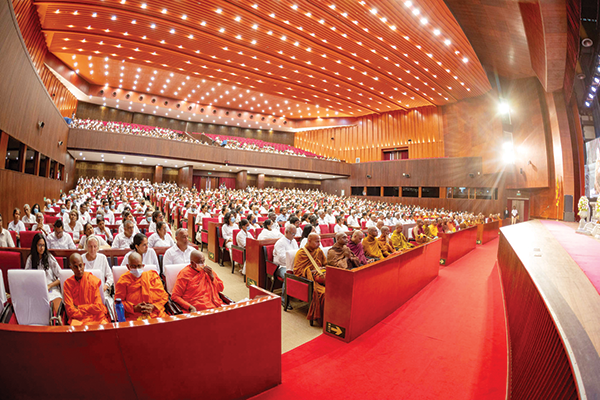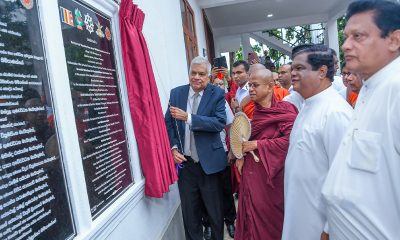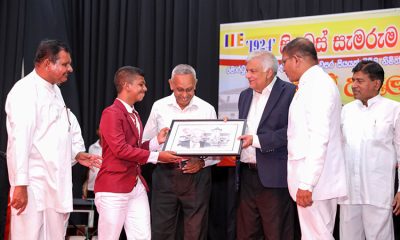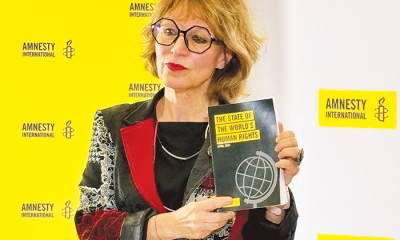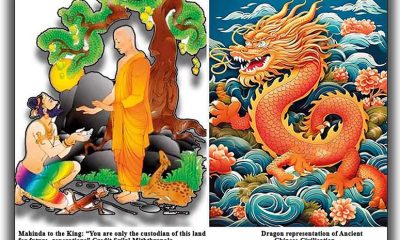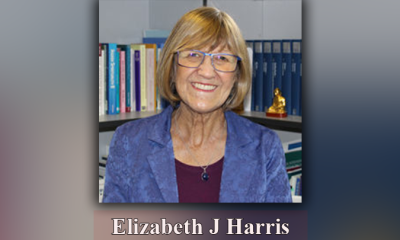Features
Thus Spake Ajahn Brahm
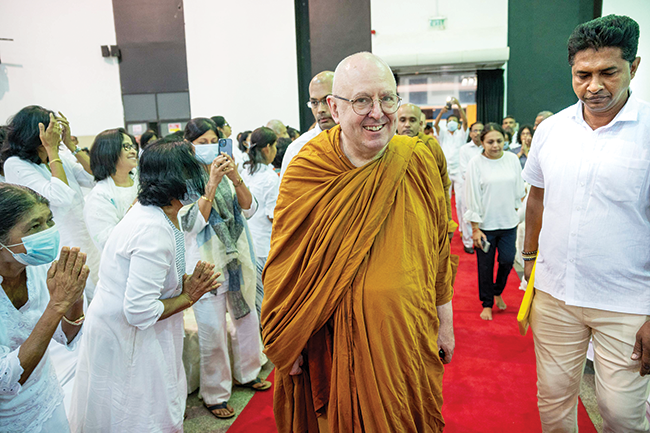
A wonderfully precious four hours at the BMICH on May 30 when Most Venerable Ajahn Brahmavamso explained some  Dhamma; conducted guided meditation; and answered queries. I came away inspired and infused with loving kindness to all, myself included. There was also gratitude to my niece, grandniece and the driver who were with me extending help and concern.
Dhamma; conducted guided meditation; and answered queries. I came away inspired and infused with loving kindness to all, myself included. There was also gratitude to my niece, grandniece and the driver who were with me extending help and concern.
Much gratitude and appreciation to Ven Mettavihari under whose guidance the members of the Ajahn Brahm Society of Sri Lanka (ABS) worked hard for many months to plan, organize and see to every little detail so that the crowded programme presented to Ajahn Brahm – visiting for 10 days – worked out smoothly with not the slightest twinge or hitch. Most appreciation is extended, of course, to Ajahn Brahm, not only for what he told us and led us to consider and think on, but for his very presence; smiling always and radiating ‘benign-ness’ and his ‘kindfulness’: a most meaningful term he coined from the two absolute necessities in life: mindfulness and loving kindness.
By 6.15 in the morning of May 30, mostly white clad, disciplined people collected at the BMICH and moved to the Main Hall and Sirimavo A and B Halls as designated in the free passes collected earlier. I reckon there were well over 7,000 who moved sedately and noiselessly to take their seats well before Ajahn Brahm was guided in to the main hall. He addressed us for about an hour, Halls A and B having two large screens each; thus able to clearly follow proceedings and see and hear Bhante. With a short interval intervening, he moved to Hall A and conducted meditation and spoke too. He moved to Hall B for the Q & A session and around 10.30 moved back to the Main Hall for summation and to give his blessing to all present, others, and the country.
Ajahn Brahm’s expressed thoughts
I need not mention that I include here only some of what the Bhikkhu said and narrate only a few of the anecdotes Ven Brahm spiced his talk with.
The first thing he said was “How beautiful your country is. When I come here monks are always smiling and happy. That’s what you can expect. Buddhism and meditation make for happiness. There is a misconception that meditation is difficult. It is not a concentration camp. Meditation is easy and most pleasant. When I was a teenager I learnt this; I meditated. Now mindfulness is taught in schools. When in Cambridge University following studies in Theoretical Physics, the final exam lasted six days. I would meditate before each of the two papers a day. This disconnected me from the stress of exam studies. I was in the present moment and not nervous at all. Often however, the brain was exhausted. But with ‘kindfulness’ I became happy. We have to know our minds. The power of the mind can sure cure illness.”
He next spoke of stillness, demonstrating with a glass with water in it. Holding it, the water was not still; placed on a table the water was still. This is symbolic of the mind. When the winds of wanting blow, the mind is disturbed. Let it go; be patient. Then the mind will be rested. “When your mind is still, you see things as they truly are. Clarity and energy of the mind increase. The power of mindfulness is great; awareness becomes very strong, very refined and you see clearly. A medical student nearly gave up studies due to cancer. He developed mindfulness, cured himself and went on to become a very caring doctor. Please do not underestimate the power of your mind, which gives a person who is thus mentally attuned, great happiness, peace of mind, eliminating stress. Of my 42 years of being a monk for 38 years I have had not a day’s illness.
“I work very hard; I meditate; I am very glad to help all people. For 35 years I have visited a cancer hospital. Some question why a Buddhist monk visits. I got to know and spoke often with a woman who had suffered greatly with breast cancer and underwent a mastectomy. She was in remission from the cancer but was totally worried about it returning. ‘What will I do if my cancer returns. How can I suffer more pain?’ she constantly asked. I posed to her the question ‘What if the cancer is cured and will not come back?’ That was an eye opener to her and set her thinking. I continued to speak to her on my visits. She changed to thinking positively. She was cured and discharged from hospital. I changed her life by guiding her to think positively.”
One feature of Ajahn Brahm’s teaching and addresses is that on the surface what he says seems simple. But my word, his anecdotes and preaching are so very meaningful and convey so much to the listener who will go deeper into what he says and gets to the significance he intends conveying. In the above instance of his address he stopped short of explanation and preaching.
The listeners had to work out what truth or advice he meant to convey. This method is much more enduring and can be remembered than the crux of the matter being revealed by the speaker.
He spoke about a student in a university in Adelaide who was so stressed that she could not leave her bed. Her uncle was a Buddhist, so he asked Ajahn Brahm to visit the bedridden girl. He asked her how she felt when a panic attack overcame her. “Tight in the chest.” He advised her to investigate and find out exactly where she felt the tightness. He gave her three days for this. Then six days of gently massaging the place of pain with loving kindness. He asked her how she felt. “Tightness has disappeared”, she replied. “Nine days more of treating yourself with love and kindness”, he suggested. She overcame her panic attacks; went on to continue her dental studies and obtained a first class degree. Now a busy dentist, the girl thanked him for saving her life.
Ajahn Brahm touched on a relevant, related topic: depression. “Depression is a low state of mind; mind has low energy; life turns boring; worries are excessive; mental exhaustion results. Don’t fight it; save your energy; build up your mental and emotional strength; determine to see much more comprehensively, hear more clearly.” Ajahn Brahm advised. His anecdote here was how when in Cambridge University, particularly during exams for the Natural Science Tripos, other students would study hard during the hour’s lunch break. He would walk and passing a clump of bamboo, would be captivated and stare long at it. Later during continued walks, after the initial wonder died down, he saw the bamboo more clearly and noticed how it seemed to miss the tropical climate that was its right. “The mind gets stronger with meditation; mindfulness opens the mind.” “Why do you smile?” he asked. “Because there is peace within you,” he replied. “This is the best makeup”, he advised.
With a broad smile and chuckle, Ajahn Brahm said that even though 72, he was much photographed, “though not famous, not a celebrity nor that handsome!” He seemed to indicate, without saying so, that his smile won him popularity, or maybe it was a mystical drawing power. So true! His smile radiates far out conveying a joyful sense of togetherness, shared calm and serenity.
Some answers abrupt but telling
The Q & A session was extremely well worked out since the questions had already been perused and translated to Sinhala. The translation of questions and the venerable monk’s answers were excellent, truly so with not one jot of content missed out. For this Ven Damita deserves applause and thanks. He is currently the abbot of Pothgulagala Forest Monastery in Devalagama, Kegalle, having ordained in 2007 and practiced meditation under Ajahn Brahm in Perth and in Thailand.
Answers were varied in length. One or two answers were extra illuminating since with a few words, Ajahn Brahm said much. One question was what he thinks of the view that some believe that the Buddha was born in Sri Lanka. Bhante read aloud the question, then pat came the answer without a moment’s hesitation: “The Buddha was born in Australia” and deadpan, he passed the piece of paper to Ven Damita. Reams were meant; unsaid.
A question dealt with peer pressure on teenagers and how to circumvent dangers. Ajahn Brahm narrated how as a teenager and young man he adopted Buddhism, kept the five precepts giving up alcohol. He thought his friends would ostracize him. On the contrary they admired and respected him and of course used him to drive them safely home after a session of heavy carousing. “Advice the young to say no firmly. Arrange for peer groups and clubs where, by consensus, they decide drugs and dissipation is not to be. In all temples on Sundays, instead of teaching again like in school, organize peer group meetings. These are safe places and spaces created for youth. Trust develops strength.”
How do I still my mind was another question. Bhante’s advice: “By practicing, not thinking nor wanting. Once you are still the mind too will become still.”
There were many more questions.
The morning ended with Ajahn Brahm being driven back to the Main Hall and a second brief session of guided meditation. He then chanted blessings which he prefaced thus: “Never think less of blessings. When Sangha chants, there is power. Chanting gives me priti. As a scientist I say this.”
We left the premises with no hassle though hundreds of vehicles were lined up. Serenity and joy were within us and we wholeheartedly gave thanks to Most Ven Ajahn Brahmavamso, Ven Mettavihari and members of the Ajahn Brahm Soceity of Sri Lanka for giving us this glorious morning of Dhamma.
Features
The heart-friendly health minister

by Dr Gotabhya Ranasinghe
Senior Consultant Cardiologist
National Hospital Sri Lanka
When we sought a meeting with Hon Dr. Ramesh Pathirana, Minister of Health, he graciously cleared his busy schedule to accommodate us. Renowned for his attentive listening and deep understanding, Minister Pathirana is dedicated to advancing the health sector. His openness and transparency exemplify the qualities of an exemplary politician and minister.
Dr. Palitha Mahipala, the current Health Secretary, demonstrates both commendable enthusiasm and unwavering support. This combination of attributes makes him a highly compatible colleague for the esteemed Minister of Health.
Our discussion centered on a project that has been in the works for the past 30 years, one that no other minister had managed to advance.
Minister Pathirana, however, recognized the project’s significance and its potential to revolutionize care for heart patients.
The project involves the construction of a state-of-the-art facility at the premises of the National Hospital Colombo. The project’s location within the premises of the National Hospital underscores its importance and relevance to the healthcare infrastructure of the nation.
This facility will include a cardiology building and a tertiary care center, equipped with the latest technology to handle and treat all types of heart-related conditions and surgeries.
Securing funding was a major milestone for this initiative. Minister Pathirana successfully obtained approval for a $40 billion loan from the Asian Development Bank. With the funding in place, the foundation stone is scheduled to be laid in September this year, and construction will begin in January 2025.
This project guarantees a consistent and uninterrupted supply of stents and related medications for heart patients. As a result, patients will have timely access to essential medical supplies during their treatment and recovery. By securing these critical resources, the project aims to enhance patient outcomes, minimize treatment delays, and maintain the highest standards of cardiac care.
Upon its fruition, this monumental building will serve as a beacon of hope and healing, symbolizing the unwavering dedication to improving patient outcomes and fostering a healthier society.We anticipate a future marked by significant progress and positive outcomes in Sri Lanka’s cardiovascular treatment landscape within the foreseeable timeframe.
Features
A LOVING TRIBUTE TO JESUIT FR. ALOYSIUS PIERIS ON HIS 90th BIRTHDAY

by Fr. Emmanuel Fernando, OMI
Jesuit Fr. Aloysius Pieris (affectionately called Fr. Aloy) celebrated his 90th birthday on April 9, 2024 and I, as the editor of our Oblate Journal, THE MISSIONARY OBLATE had gone to press by that time. Immediately I decided to publish an article, appreciating the untiring selfless services he continues to offer for inter-Faith dialogue, the renewal of the Catholic Church, his concern for the poor and the suffering Sri Lankan masses and to me, the present writer.
It was in 1988, when I was appointed Director of the Oblate Scholastics at Ampitiya by the then Oblate Provincial Fr. Anselm Silva, that I came to know Fr. Aloy more closely. Knowing well his expertise in matters spiritual, theological, Indological and pastoral, and with the collaborative spirit of my companion-formators, our Oblate Scholastics were sent to Tulana, the Research and Encounter Centre, Kelaniya, of which he is the Founder-Director, for ‘exposure-programmes’ on matters spiritual, biblical, theological and pastoral. Some of these dimensions according to my view and that of my companion-formators, were not available at the National Seminary, Ampitiya.
Ever since that time, our Oblate formators/ accompaniers at the Oblate Scholasticate, Ampitiya , have continued to send our Oblate Scholastics to Tulana Centre for deepening their insights and convictions regarding matters needed to serve the people in today’s context. Fr. Aloy also had tried very enthusiastically with the Oblate team headed by Frs. Oswald Firth and Clement Waidyasekara to begin a Theologate, directed by the Religious Congregations in Sri Lanka, for the contextual formation/ accompaniment of their members. It should very well be a desired goal of the Leaders / Provincials of the Religious Congregations.
Besides being a formator/accompanier at the Oblate Scholasticate, I was entrusted also with the task of editing and publishing our Oblate journal, ‘The Missionary Oblate’. To maintain the quality of the journal I continue to depend on Fr. Aloy for his thought-provoking and stimulating articles on Biblical Spirituality, Biblical Theology and Ecclesiology. I am very grateful to him for his generous assistance. Of late, his writings on renewal of the Church, initiated by Pope St. John XX111 and continued by Pope Francis through the Synodal path, published in our Oblate journal, enable our readers to focus their attention also on the needed renewal in the Catholic Church in Sri Lanka. Fr. Aloy appreciated very much the Synodal path adopted by the Jesuit Pope Francis for the renewal of the Church, rooted very much on prayerful discernment. In my Religious and presbyteral life, Fr.Aloy continues to be my spiritual animator / guide and ongoing formator / acccompanier.
Fr. Aloysius Pieris, BA Hons (Lond), LPh (SHC, India), STL (PFT, Naples), PhD (SLU/VC), ThD (Tilburg), D.Ltt (KU), has been one of the eminent Asian theologians well recognized internationally and one who has lectured and held visiting chairs in many universities both in the West and in the East. Many members of Religious Congregations from Asian countries have benefited from his lectures and guidance in the East Asian Pastoral Institute (EAPI) in Manila, Philippines. He had been a Theologian consulted by the Federation of Asian Bishops’ Conferences for many years. During his professorship at the Gregorian University in Rome, he was called to be a member of a special group of advisers on other religions consulted by Pope Paul VI.
Fr. Aloy is the author of more than 30 books and well over 500 Research Papers. Some of his books and articles have been translated and published in several countries. Among those books, one can find the following: 1) The Genesis of an Asian Theology of Liberation (An Autobiographical Excursus on the Art of Theologising in Asia, 2) An Asian Theology of Liberation, 3) Providential Timeliness of Vatican 11 (a long-overdue halt to a scandalous millennium, 4) Give Vatican 11 a chance, 5) Leadership in the Church, 6) Relishing our faith in working for justice (Themes for study and discussion), 7) A Message meant mainly, not exclusively for Jesuits (Background information necessary for helping Francis renew the Church), 8) Lent in Lanka (Reflections and Resolutions, 9) Love meets wisdom (A Christian Experience of Buddhism, 10) Fire and Water 11) God’s Reign for God’s poor, 12) Our Unhiddden Agenda (How we Jesuits work, pray and form our men). He is also the Editor of two journals, Vagdevi, Journal of Religious Reflection and Dialogue, New Series.
Fr. Aloy has a BA in Pali and Sanskrit from the University of London and a Ph.D in Buddhist Philosophy from the University of Sri Lankan, Vidyodaya Campus. On Nov. 23, 2019, he was awarded the prestigious honorary Doctorate of Literature (D.Litt) by the Chancellor of the University of Kelaniya, the Most Venerable Welamitiyawe Dharmakirthi Sri Kusala Dhamma Thera.
Fr. Aloy continues to be a promoter of Gospel values and virtues. Justice as a constitutive dimension of love and social concern for the downtrodden masses are very much noted in his life and work. He had very much appreciated the commitment of the late Fr. Joseph (Joe) Fernando, the National Director of the Social and Economic Centre (SEDEC) for the poor.
In Sri Lanka, a few religious Congregations – the Good Shepherd Sisters, the Christian Brothers, the Marist Brothers and the Oblates – have invited him to animate their members especially during their Provincial Congresses, Chapters and International Conferences. The mainline Christian Churches also have sought his advice and followed his seminars. I, for one, regret very much, that the Sri Lankan authorities of the Catholic Church –today’s Hierarchy—- have not sought Fr.
Aloy’s expertise for the renewal of the Catholic Church in Sri Lanka and thus have not benefited from the immense store of wisdom and insight that he can offer to our local Church while the Sri Lankan bishops who governed the Catholic church in the immediate aftermath of the Second Vatican Council (Edmund Fernando OMI, Anthony de Saram, Leo Nanayakkara OSB, Frank Marcus Fernando, Paul Perera,) visited him and consulted him on many matters. Among the Tamil Bishops, Bishop Rayappu Joseph was keeping close contact with him and Bishop J. Deogupillai hosted him and his team visiting him after the horrible Black July massacre of Tamils.
Features
A fairy tale, success or debacle

Sri Lanka-Singapore Free Trade Agreement
By Gomi Senadhira
senadhiragomi@gmail.com
“You might tell fairy tales, but the progress of a country cannot be achieved through such narratives. A country cannot be developed by making false promises. The country moved backward because of the electoral promises made by political parties throughout time. We have witnessed that the ultimate result of this is the country becoming bankrupt. Unfortunately, many segments of the population have not come to realize this yet.” – President Ranil Wickremesinghe, 2024 Budget speech
Any Sri Lankan would agree with the above words of President Wickremesinghe on the false promises our politicians and officials make and the fairy tales they narrate which bankrupted this country. So, to understand this, let’s look at one such fairy tale with lots of false promises; Ranil Wickremesinghe’s greatest achievement in the area of international trade and investment promotion during the Yahapalana period, Sri Lanka-Singapore Free Trade Agreement (SLSFTA).
It is appropriate and timely to do it now as Finance Minister Wickremesinghe has just presented to parliament a bill on the National Policy on Economic Transformation which includes the establishment of an Office for International Trade and the Sri Lanka Institute of Economics and International Trade.
Was SLSFTA a “Cleverly negotiated Free Trade Agreement” as stated by the (former) Minister of Development Strategies and International Trade Malik Samarawickrama during the Parliamentary Debate on the SLSFTA in July 2018, or a colossal blunder covered up with lies, false promises, and fairy tales? After SLSFTA was signed there were a number of fairy tales published on this agreement by the Ministry of Development Strategies and International, Institute of Policy Studies, and others.
However, for this article, I would like to limit my comments to the speech by Minister Samarawickrama during the Parliamentary Debate, and the two most important areas in the agreement which were covered up with lies, fairy tales, and false promises, namely: revenue loss for Sri Lanka and Investment from Singapore. On the other important area, “Waste products dumping” I do not want to comment here as I have written extensively on the issue.
1. The revenue loss
During the Parliamentary Debate in July 2018, Minister Samarawickrama stated “…. let me reiterate that this FTA with Singapore has been very cleverly negotiated by us…. The liberalisation programme under this FTA has been carefully designed to have the least impact on domestic industry and revenue collection. We have included all revenue sensitive items in the negative list of items which will not be subject to removal of tariff. Therefore, 97.8% revenue from Customs duty is protected. Our tariff liberalisation will take place over a period of 12-15 years! In fact, the revenue earned through tariffs on goods imported from Singapore last year was Rs. 35 billion.
The revenue loss for over the next 15 years due to the FTA is only Rs. 733 million– which when annualised, on average, is just Rs. 51 million. That is just 0.14% per year! So anyone who claims the Singapore FTA causes revenue loss to the Government cannot do basic arithmetic! Mr. Speaker, in conclusion, I call on my fellow members of this House – don’t mislead the public with baseless criticism that is not grounded in facts. Don’t look at petty politics and use these issues for your own political survival.”
I was surprised to read the minister’s speech because an article published in January 2018 in “The Straits Times“, based on information released by the Singaporean Negotiators stated, “…. With the FTA, tariff savings for Singapore exports are estimated to hit $10 million annually“.
As the annual tariff savings (that is the revenue loss for Sri Lanka) calculated by the Singaporean Negotiators, Singaporean $ 10 million (Sri Lankan rupees 1,200 million in 2018) was way above the rupees’ 733 million revenue loss for 15 years estimated by the Sri Lankan negotiators, it was clear to any observer that one of the parties to the agreement had not done the basic arithmetic!
Six years later, according to a report published by “The Morning” newspaper, speaking at the Committee on Public Finance (COPF) on 7th May 2024, Mr Samarawickrama’s chief trade negotiator K.J. Weerasinghehad had admitted “…. that forecasted revenue loss for the Government of Sri Lanka through the Singapore FTA is Rs. 450 million in 2023 and Rs. 1.3 billion in 2024.”
If these numbers are correct, as tariff liberalisation under the SLSFTA has just started, we will pass Rs 2 billion very soon. Then, the question is how Sri Lanka’s trade negotiators made such a colossal blunder. Didn’t they do their basic arithmetic? If they didn’t know how to do basic arithmetic they should have at least done their basic readings. For example, the headline of the article published in The Straits Times in January 2018 was “Singapore, Sri Lanka sign FTA, annual savings of $10m expected”.
Anyway, as Sri Lanka’s chief negotiator reiterated at the COPF meeting that “…. since 99% of the tariffs in Singapore have zero rates of duty, Sri Lanka has agreed on 80% tariff liberalisation over a period of 15 years while expecting Singapore investments to address the imbalance in trade,” let’s turn towards investment.
Investment from Singapore
In July 2018, speaking during the Parliamentary Debate on the FTA this is what Minister Malik Samarawickrama stated on investment from Singapore, “Already, thanks to this FTA, in just the past two-and-a-half months since the agreement came into effect we have received a proposal from Singapore for investment amounting to $ 14.8 billion in an oil refinery for export of petroleum products. In addition, we have proposals for a steel manufacturing plant for exports ($ 1 billion investment), flour milling plant ($ 50 million), sugar refinery ($ 200 million). This adds up to more than $ 16.05 billion in the pipeline on these projects alone.
And all of these projects will create thousands of more jobs for our people. In principle approval has already been granted by the BOI and the investors are awaiting the release of land the environmental approvals to commence the project.
I request the Opposition and those with vested interests to change their narrow-minded thinking and join us to develop our country. We must always look at what is best for the whole community, not just the few who may oppose. We owe it to our people to courageously take decisions that will change their lives for the better.”
According to the media report I quoted earlier, speaking at the Committee on Public Finance (COPF) Chief Negotiator Weerasinghe has admitted that Sri Lanka was not happy with overall Singapore investments that have come in the past few years in return for the trade liberalisation under the Singapore-Sri Lanka Free Trade Agreement. He has added that between 2021 and 2023 the total investment from Singapore had been around $162 million!
What happened to those projects worth $16 billion negotiated, thanks to the SLSFTA, in just the two-and-a-half months after the agreement came into effect and approved by the BOI? I do not know about the steel manufacturing plant for exports ($ 1 billion investment), flour milling plant ($ 50 million) and sugar refinery ($ 200 million).
However, story of the multibillion-dollar investment in the Petroleum Refinery unfolded in a manner that would qualify it as the best fairy tale with false promises presented by our politicians and the officials, prior to 2019 elections.
Though many Sri Lankans got to know, through the media which repeatedly highlighted a plethora of issues surrounding the project and the questionable credentials of the Singaporean investor, the construction work on the Mirrijiwela Oil Refinery along with the cement factory began on the24th of March 2019 with a bang and Minister Ranil Wickremesinghe and his ministers along with the foreign and local dignitaries laid the foundation stones.
That was few months before the 2019 Presidential elections. Inaugurating the construction work Prime Minister Ranil Wickremesinghe said the projects will create thousands of job opportunities in the area and surrounding districts.
The oil refinery, which was to be built over 200 acres of land, with the capacity to refine 200,000 barrels of crude oil per day, was to generate US$7 billion of exports and create 1,500 direct and 3,000 indirect jobs. The construction of the refinery was to be completed in 44 months. Four years later, in August 2023 the Cabinet of Ministers approved the proposal presented by President Ranil Wickremesinghe to cancel the agreement with the investors of the refinery as the project has not been implemented! Can they explain to the country how much money was wasted to produce that fairy tale?
It is obvious that the President, ministers, and officials had made huge blunders and had deliberately misled the public and the parliament on the revenue loss and potential investment from SLSFTA with fairy tales and false promises.
As the president himself said, a country cannot be developed by making false promises or with fairy tales and these false promises and fairy tales had bankrupted the country. “Unfortunately, many segments of the population have not come to realize this yet”.
(The writer, a specialist and an activist on trade and development issues . )

